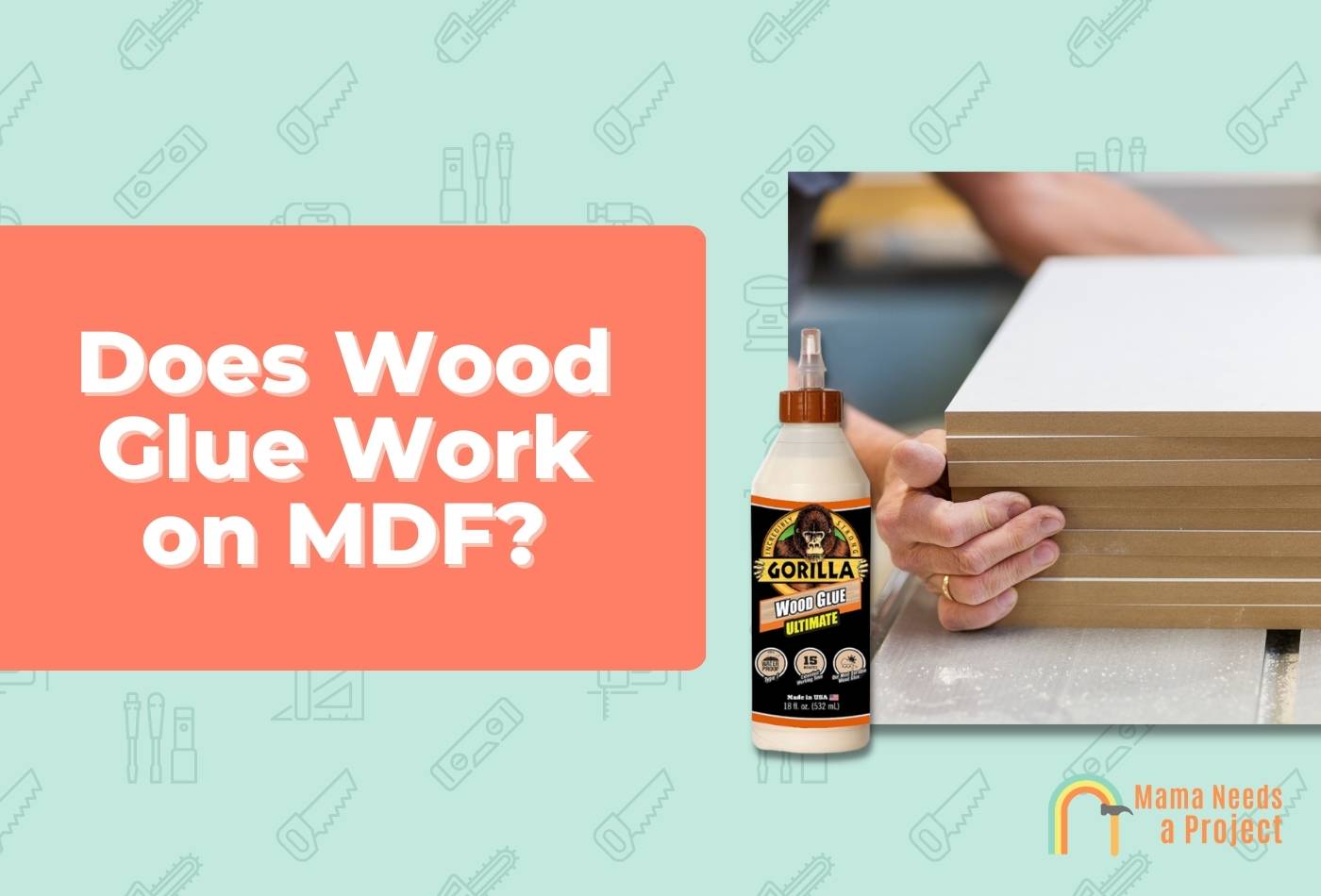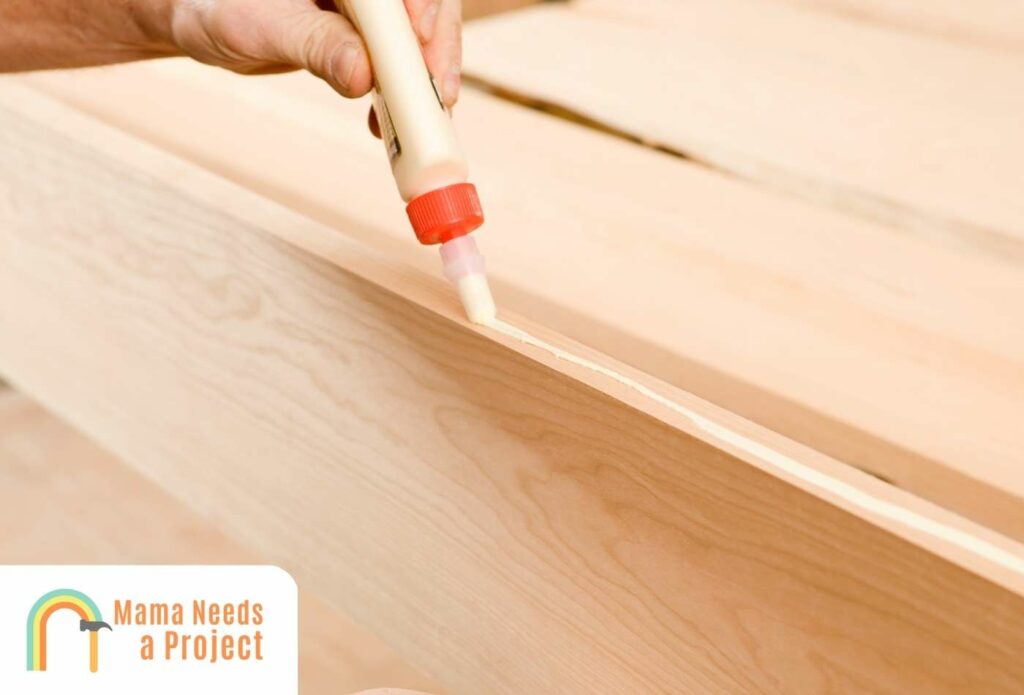Let’s talk about a common DIY question: Can you glue MDF with wood glue? If you’re into crafting or woodworking, this question might have crossed your mind. Well, it’s time to find out the answer and discover some useful tips along the way.
MDF, short for Medium-Density Fiberboard, is a popular material in woodworking projects. And wood glue is a go-to adhesive for many tasks. But can these two work together? Stick around to learn all about it and unleash your creativity in your next projects.
In this guide, we’ll explore the compatibility of MDF and wood glue and delve into the dos and don’ts of achieving a strong bond. So, grab your glue gun and brace yourself for an adhesive adventure!

Can You Glue MDF with Wood Glue?
When it comes to working with Medium Density Fiberboard (MDF), one common question that arises is whether you can use wood glue to bond this engineered wood product. MDF is a versatile material that is commonly used in furniture and cabinetry construction due to its affordability and smooth finish. However, its composition poses some challenges when it comes to gluing. In this article, we will explore the characteristics of MDF and delve into whether wood glue is an effective option for bonding this material.
The Composition of MDF
Before we can determine whether wood glue is suitable for MDF, it’s crucial to understand the composition of the material. MDF is made by compressing wood fibers with an adhesive resin under high pressure and temperature. Unlike natural wood, MDF does not have a grain structure and is uniform in its composition. Additionally, it has a porous surface, which can affect the adhesive’s ability to penetrate and bond with the fibers.
Can You Use Wood Glue on MDF?
The short answer is yes, you can use wood glue on MDF. Wood glue, often referred to as carpenter’s glue or PVA glue, is an adhesive designed specifically for woodworking projects. It is a water-based glue that offers strong bonding capabilities. However, there are a few factors to consider to ensure a successful bond between wood glue and MDF.
Firstly, it’s important to prepare the MDF surface before applying the wood glue. Since MDF has a smooth and porous surface, it is recommended to sand the area to improve the adhesion. Sanding creates a rougher texture, allowing the glue to penetrate the surface more effectively. Additionally, it is advisable to remove any dust or debris from the surface before applying the wood glue.
Secondly, choosing the right type of wood glue is crucial for bonding MDF. Opt for a high-quality wood glue that is specifically formulated for porous surfaces. Some wood glues are designed for tighter, non-porous joints, so make sure to select one that suits your project requirements. It is also recommended to follow the manufacturer’s instructions for application and drying times to ensure the best results.
The Benefits of Using Wood Glue on MDF
Using wood glue on MDF offers several advantages. Firstly, wood glue creates a strong bond that can withstand the stresses and strains of typical furniture and cabinetry use. It provides excellent adhesion, ensuring that your MDF pieces stay securely bonded together. Secondly, wood glue is easily accessible and affordable, making it a cost-effective option for DIYers and professionals alike. Finally, wood glue dries clear and can be sanded down to create a seamless finish, enhancing the overall appearance of your project.
When using wood glue on MDF, it’s important to consider the limitations of the material. MDF is highly susceptible to moisture, and excessive exposure to water can cause swelling and deformation. Therefore, it is important to protect your glued MDF projects from moisture and avoid using them in high humidity environments or areas prone to water damage.
Other Suitable Adhesives for MDF
While wood glue is a popular choice for bonding MDF, there are other adhesives that you can consider depending on your project requirements.
1. Polyurethane Glue:
Polyurethane glue, also known as PU glue, is a versatile adhesive that forms a strong bond with MDF. It is ideal for projects that require a waterproof or weather-resistant bond. PU glue expands as it cures, filling any gaps or irregularities in the MDF surface. However, it is important to note that polyurethane glue has a longer curing time and may require clamping to ensure a tight bond.
2. Cyanoacrylate (CA) Glue:
CA glue, commonly referred to as super glue, is another option for bonding MDF. It is a fast-setting adhesive that provides high bond strength. CA glue works well for small projects or areas that require instant bonding. However, it is essential to use CA glue sparingly, as excessive application can cause the MDF to become brittle.
3. Epoxy:
Epoxy is a two-part adhesive that offers a strong bond and is ideal for projects that require high strength and durability. It is commonly used in applications where MDF will be exposed to heavy loads or frequent movement. Epoxy provides excellent gap filling capabilities and is resistant to moisture and temperature variations.
Tips for Gluing MDF
When working with MDF and any type of adhesive, it’s essential to follow some guidelines to ensure a successful bond. Here are some tips for gluing MDF:
- Prepare the MDF surface by sanding it to create a rougher texture for better adhesion.
- Clean the MDF surface thoroughly, removing any dust or debris.
- Apply a thin, even layer of adhesive to both surfaces being bonded.
- Use clamps or weights to ensure a tight bond while the adhesive cures.
- Follow the manufacturer’s instructions for drying times and curing processes.
- Avoid excessive exposure to moisture or high humidity, as MDF is sensitive to water.
- Test the bonding strength before subjecting the glued MDF to heavy loads or stress.
- Consider using reinforcing methods such as screws or dowels for additional strength.
- Always work in a well-ventilated area and wear appropriate protective gear when working with adhesives.
Conclusion
While wood glue is a suitable option for bonding MDF, it’s important to ensure proper surface preparation and choose the right type of adhesive for your project needs. Whether you opt for wood glue, polyurethane glue, cyanoacrylate glue, or epoxy, following the recommended guidelines will help you achieve a strong and durable bond. Remember to consider the limitations of MDF and take measures to protect your glued projects from excessive moisture. With the right adhesive and techniques, you can successfully bond MDF and create beautiful, long-lasting woodworking projects.
Key Takeaways: Can You Glue MDF with Wood Glue?
- Yes, you can glue MDF (Medium Density Fiberboard) with wood glue.
- Wood glue is a great adhesive for joining MDF pieces together.
- Make sure the surfaces are clean and dry before applying the wood glue.
- Apply the wood glue evenly on both surfaces and press them together firmly.
- Allow the glue to dry for the recommended time before handling the glued MDF.
Frequently Asked Questions
Welcome to our Frequently Asked Questions section, where we address common queries about gluing MDF with wood glue. Read on to find the answers you’re looking for!
Q: Can I use wood glue to glue MDF together?
A: Yes, absolutely! Wood glue is a great adhesive for joining MDF panels. However, it’s important to choose the right type of wood glue specifically designed for MDF. Look for a glue that mentions MDF on the label or is suitable for bonding wood with a smooth surface. This type of glue will provide the best results, ensuring a strong and durable bond between the MDF pieces.
When using wood glue to glue MDF, make sure to apply an even layer of glue to both surfaces that need to be joined. Then, firmly press the pieces together and use clamps or weights to hold them in place while the glue dries. Always follow the manufacturer’s instructions on the glue bottle for specific drying times and precautions.
Q: Is wood glue better than other types of adhesives for gluing MDF?
A: Wood glue is an excellent choice for gluing MDF because it is specifically formulated to bond wood and wood-based materials like MDF. It creates a strong and reliable bond that can withstand the test of time. Other adhesives, such as general-purpose or construction adhesives, may not be as effective when it comes to bonding MDF.
Wood glue has certain properties that make it ideal for MDF. It has a high viscosity, meaning it’s thick and doesn’t run, allowing for precise application. It also has good gap-filling capabilities, which is important when working with MDF as it does not have the same structural integrity as solid wood. Overall, wood glue provides the best combination of strength, durability, and ease of use when gluing MDF.
Q: Can I use regular white glue instead of wood glue for MDF?
A: While white glue, such as school glue or craft glue, can be used for some woodworking projects, it is generally not recommended for gluing MDF. White glue is designed for porous materials like paper, fabric, or wood with open grain, and it may not create a strong bond with MDF’s smooth surface.
To ensure a secure and long-lasting bond, it is best to use wood glue specifically formulated for MDF. These types of glues have the right viscosity, gap-filling properties, and adhesion strength needed to bond MDF effectively.
Q: How long does it take for wood glue to dry when gluing MDF?
A: The drying time of wood glue used to bond MDF depends on various factors, including the type of wood glue, temperature, humidity level, and the thickness of the glue layer. However, as a general guideline, most wood glues used for MDF bonding will dry within 20-30 minutes.
Keep in mind that this is only an estimate, and it’s important to follow the specific instructions provided by the manufacturer of the wood glue you are using. Some wood glues might require longer drying times, especially in colder or more humid conditions. It’s also a good idea to allow the glued MDF pieces to dry for at least 24 hours before subjecting them to any stress or load.
Q: Can I sand the glued MDF after it has dried?
A: Yes, you can sand the glued MDF after the adhesive has fully dried. Sanding allows you to smooth out any uneven surfaces, remove excess glue, and create a seamless finish. However, it’s essential to wait until the glue has completely cured before sanding. This usually takes around 24 hours.
When sanding glued MDF, use a fine-grit sandpaper or a sanding block to avoid damaging the surface. It’s also a good idea to wear a mask and work in a well-ventilated area to protect yourself from any dust particles that may be released during the sanding process. Take your time and sand gently to achieve the desired result without compromising the integrity of the glued joint.

Best glue for MDF joints
Summary
So, can you glue MDF with wood glue? The answer is yes! Wood glue works well on MDF as long as you prepare the surface properly. Make sure to sand the edges, apply pressure when gluing, and allow enough drying time.
However, keep in mind that MDF is not as strong as real wood and may not be suitable for certain heavy-duty projects. It’s always a good idea to test the glue on a scrap piece of MDF before committing to a larger project. Remember, follow the instructions on the wood glue bottle and take your time for the best results.
